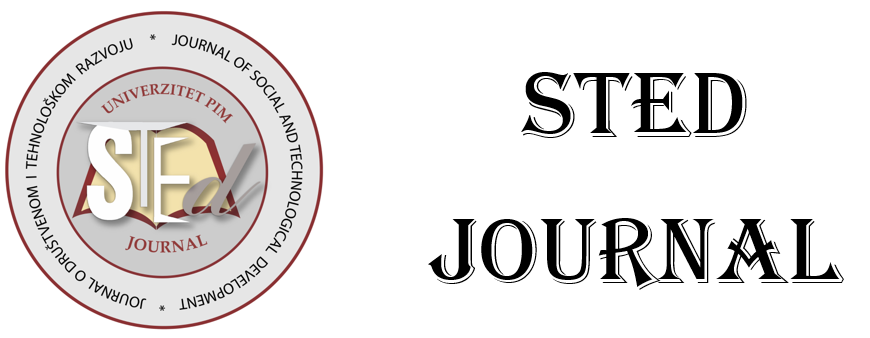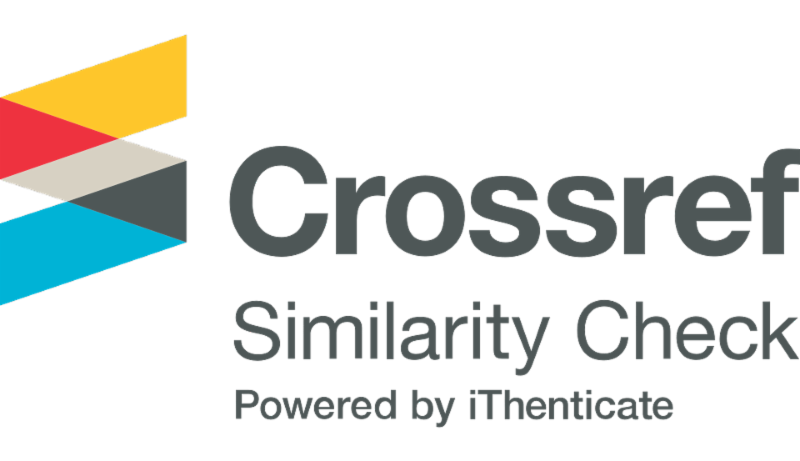Vol 6, No 1 (2024)
Published: 30.04.2024.
Authors in this issue:
Biljana Ilić, Bojana Ostojić, Boris Latinovic, Darko Vaselić, Davor Radivojević, Dejan Baskic, Jelena Petronijević, Jelena Jovović, Ljubica Janjetović, Marina Serafinović, Milutin Pećić, Mirjana Milovanović, Nenad Janković, Nenad Joksimović, Nikola Novaković, Nikola Vojvodić, Obrad Čabarkapa, Slađana Lolić, Svetlana Dušanić-Gačić,
Edited by:
Dr Dejan Kojić
Author guidelines
Editorial Policy
14
Issues126
ArticlesSTED Journal
Aim and Scope
Open Access
Open access, Copyright policy and APC
Publication Ethics
Publications Ethics and Publication Malpractice Statement
Archive
See all
Volume 7, Issue 2, 2025
Volume 7, Issue 1, 2025
Volume 6, Issue 2, 2024
Volume 6, Issue 1, 2024
30.04.2024.
Original scientific paper
ANTICANCER POTENTIAL OF NOVEL PALLADIUM(II) COMPLEXES WITH ACYL PYRUVATES AS LIGANDS: DNA AND BSA INTERACTIONS AND MOLECULAR DOCKING STUDY
Bearing in mind that some palladium complexes showed good antitumor potential while exhibiting less kidney toxicity comparing to cisplatin, to discover a new agents for chemotherapy with improved properties two novel palladium(II) complexes [Pd (L)2] (3A and 3B) with acyl pyruvates (O,O bidentate ligands) were synthesized and characterized by spectral (UV-Vis, IR, NMR, ESI-MS) and elemental analysis. The novel palladium(II) complexes were analyzed for their cytotoxic potential on human cancer cell lines (HeLa and MDA-MB 231) and normal fibroblasts (MRC-5). Results showed that complex 3A displayed very good cytotoxic activity, while complex 3B had moderate activity on the tested tumor cell lines. After 48h incubation with complex 3A, his IC50 values were similar to the IC50 values of cisPt. Notably, all IC50 of complex 3A on human fetal lung fibroblasts (MRC-5) were higher than 100 μM, indicating good selectivity. In addition, complex 3A induced apoptotic type of cell death, cell cycle arrest in G0/G1 phase in both HeLa and MDA-MB 231 cell lines. In addition, we revealed that 3A can be useful as adjuvants in cancer therapy by reducing the dose of cisplatin and in this manner its’ side effects. For the investigations of interactions between novel palladium(II) complex 3A and CT-DNA or bovine serum albumin (BSA) fluorometric titrations method was used. The obtained results implied that 3A has great affinity to displace ethidium bromide (EB) from the EB-DNA complex through intercalation, suggesting strong competition with EB. Results in fluorescence titration of BSA with complex 3A showed that the fluorescence quenching of BSA happens because of the formation of the 3A-BSA complex. Obtained Ka value is in the optimal range signifying that appropriate amount of 3A can be transported and distributed through the cells. In order to better understand the binding of newly synthesized complex 3A to BSA or DNA, molecular docking study was further performed.
Nenad Joksimović, Jelena Petronijević, Marina Serafinović, Nenad Janković, Dejan Baskic
30.04.2024.
Original scientific paper
ANALYSIS OF ECONOMIC AND BUSINESS INDICATORS OF ENTREPRENEURSHIP IN REPUBLIC OF SRPSKA
The article examines the role of small, medium and large enterprises in the economy of Republic of Srpska for the period from 2014 to 2022 year. The authors analyzed the economic indicators, according to company size (profitability rate, labor costs per employee, added value per employed person – productivity, employees – annual average and average wages paid per employed person), and also annual business indicators by company size (number of entrepreneurs, number of employees, number of companies and turnover). The aim of the paper is to analyze the operations of SMEs in order to give recommendations for future business improvement and to indicate the main obstacles and weaknesses as well as recommendations. The method of description and classification of data and the method of analysis and synthesis were used in order to achieve the objectives of the research.
Mirjana Milovanović, Svetlana Dušanić-Gačić, Svetlana Dušanić-Gačić
30.04.2024.
Original scientific paper
MARKETING STRATEGIES IN RECRUITING AND TRAINING VOLUNTEERS FOR THE ORGANIZATION OF SPORTS COMPETITIONS
The study paper’s focus is on establishing the connection between marketing initiatives and the strategy used by numerous volunteers to plan sporting events. The manager of the volunteer sector is responsible for assembling a project team and overseeing the recruiting, selection, training, deployment, supervision, and coordination of volunteers while they work as volunteers at major sporting events. The greatest candidates for this position are coordinators for the volunteer sector who have experience as volunteers, as they can inspire others to perform selfless volunteer work. Research has shown that in order to effectively oversee 800 unpaid employees, someone must first build a direct relationship with them—something that can only be done in the event that there are a significant number of trained coordinators. Additionally, it is essential to heavily publicize the volunteer contest and emphasize the advantages that volunteers obtain by taking part in order to attract a big number of participants. In addition to the aforementioned, well-planned, organized, intricate, and gradual preparation that begins several months prior to the competition is required to prepare a big number of volunteers for high-quality and committed involvement at a sporting event. After receiving top-notch training, volunteers can serve in any area of the competition. Additionally, volunteers who have previously taken part in a well-run sporting event typically return to sports volunteering multiple times. Ultimately, the paper’s set hypothesis—which related to the contention that there is a positive connection between marketing initiatives, sports event organization, and the approach of volunteers.
Boris Latinovic, Bojana Ostojić, Biljana Ilić, Milutin Pećić, Obrad Čabarkapa
30.04.2024.
Original scientific paper
ARTIFICIAL INTELLIGENCE: EFFECTS ON SOCIETY, THE ECONOMY, AND ITS REGULATION
The beginnings of artificial intelligence are linked to 1956 and the Dartmouth conference organized by Stanford University. From those beginnings until the end of the 20th century, its development was relatively slow due to hardware and software limitations. However, the 21st century brings a turning point in every sense. ln the 21st century, there was also a division into specialized artificial intelligence, which was primarily developed in the 20th century, and general artificial intelligence, on which the focus of development has been placed in recent decades. The positive economic effects of the adoption of artificial intelligence, according to the conducted research, are unequivocal. The effects on individuals and humanity are significantly more open to discussion. Almost half of the respondents in the conducted research are not in favor of accepting artificial intelligence for private purposes, and the other half is almost equally divided between those who do not have an opinion on this issue and those who are not against its acceptance. About 70% of respondents believe that artificial intelligence can become a threat to humanity and the mental health of individuals. At the same time, the majority of respondents do not see challenges in their employment. As a solution, the respondents see a clear and strict regulation of the development and possibilities of artificial intelligence itself. Institutions of the society we live in and companies that develop artificial intelligence are seen as responsible for this regulation. A real step in this direction was taken by the European Union with the adoption of the Act on Artificial Intelligence in March 2024. What is expected is that this example of the EU will be followed by other countries, which would ensure the correct development and use of artificial intelligence for the general benefit of humanity, which it should serve.
Darko Vaselić, Nikola Vojvodić, Jelena Jovović
30.04.2024.
Short scientific paper
BLOCKCHAIN IN PUBLIC ADMINISTRATION IN BOSNIA AND HERZEGOVINA
In this paper, we explore the potential of blockchain technology to enhance public administration efficiency in Bosnia and Herzegovina. Facing challenges in communication and service delivery between the government and its citizens, our research investigates how blockchain can provide solutions. We employed questionnaires to gather citizens' opinions and conducted a comparative analysis of best practices from countries that have successfully implemented blockchain in public sectors. This approach allows us to identify specific areas where blockchain, particularly through smart contracts and hybrid networks, can improve efficiencies and outcomes. Blockchain technology, known for its decentralization, transparency, and security features, shows promise in several sectors, including finance, cryptocurrency, business support, and law, offering substantial benefits. Our analysis suggests that by adopting similar strategies, Bosnia and Herzegovina can address many current issues undermining public administration effectiveness. Our findings, based on citizens' feedback and international case studies, indicate that the existing system falls short in efficiency, underscoring the need for innovative solutions like blockchain to enhance public service delivery. We acknowledge potential challenges in implementation, such as technological infrastructure, legal frameworks, and socioeconomic considerations. Despite these hurdles, our research presents a compelling case for blockchain technology as a means to facilitate more effective communication and services between the government and its citizens. We conclude with recommendations for adopting blockchain technology in Bosnia and Herzegovina's public administration, supported by our comparative analysis and questionnaire insights. Additionally, we suggest areas for future research to continue exploring the transformative potential of blockchain in public services
Nikola Novaković, Davor Radivojević
30.04.2024.
Short scientific paper
ATTITUDES OF DIGITAL TECHNOLOGY USERS ON THEIR IMPACT ON DAILY LIFE, WORK, AND MENTAL HEALTH
The digital technological revolution began in the second half of the last century. Its development in the first decades after the discovery of the transistor was rather slow. Acceleration and a wider awareness of the possibilities began to spread after the introduction of the Internet. And then the last two decades brought rapid development of digital technologies and general acceptance in private and business life. The benefits for individuals, companies, institutions and society as a whole are enormous and unquestionable. Nevertheless, bearing in mind the conducted studies on the degree of digitization of certain areas of society and certain countries, it is considered that the potential is huge. And significant breakthroughs supported by artificial intelligence are still expected. However, in addition to the undoubted benefits, there are also certain negatives, which are not sufficiently clarified or which are often obscured. Therefore, this paper aimed to determine the attitudes of the users themselves towards digital technologies, and in its last part, it examined the existence of negative effects on the mental health of users of digital technologies. The results are expected in the part of the examination of the benefits arising from the use of digital technologies. The existence of negative effects on the health of users is not a surprise either. The surprise is the degree of negative impact and lack of corrective action by the user. In other words, users are aware of the negatives that arise from, primarily, the excessive use of digital technologies, but they still do almost nothing to reduce these negative consequences.
Darko Vaselic, Ljubica Janjetović
30.04.2024.
Review scientific paper
PROBLEM TEACHING OF MATHEMATICS
Observed from the school education system, it can be said that the entire educational activity should respect the needs and possibilities of each student and develop his potential to the maximum. In parallel with the development of students' potential, the students' needs for everyday coping and solving problem situations also grow. Contemporary views on students' acquisition of knowledge and skills in mathematics teaching is learning through inquiry and problem solving. In this paper, we will answer the question whether the application of problem-based teaching makes the teaching of mathematics interesting for students. We will examine how students, parents and teachers think, to what extent the application of problem-based learning, teaching and problem solving in mathematics classes makes mathematics teaching interesting for students, from the perspective of students, parents and teachers.
Slađana Lolić












